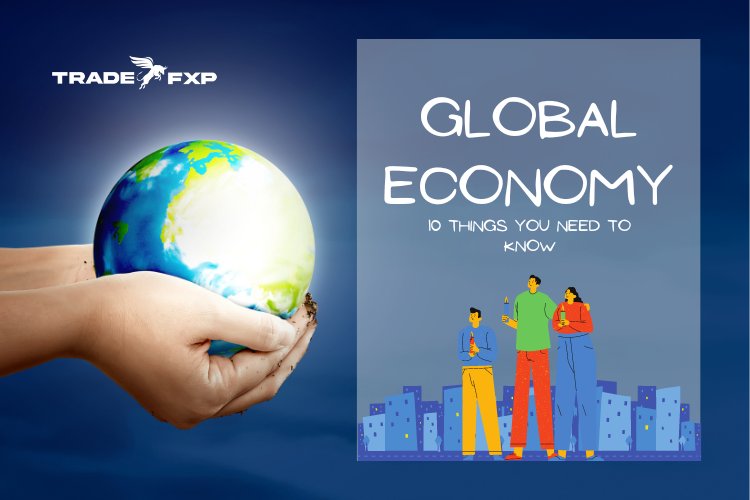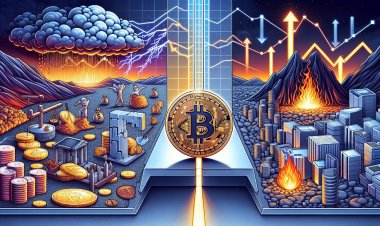The Global Economy: 10 Things You Didn't Know
Unveiling surprising facts about the global economy, this enlightening blog delves into 10 unknown facets that are shaping our financial world. Get informed now.

The global economy is an ever-changing entity, which is why everyone needs to understand it. The full story, however, is not known to most people. In this blog post, we'll explore 10 facts that you may not know about the global economy. From its history to what's in store, read on to learn more about our world and how it works today.
Global economic growth is on the rise. There is an expansion of the global economy
A variety of factors make up the global economy, and it's constantly growing and changing. Here are a few things you might not know about it:
There are 78 trillion dollars in the global economy - that's a lot of money!
On a global scale, the United States has the largest economy, followed by China, Japan, Germany, and India. By 2040, some experts predict that the global economy will double. Agriculture, manufacturing, trade, tourism, and many other industries contribute to the global economy.
The United States has the largest economy in the world.
United States Gross Domestic Product (GDP) is $17.4 trillion, which is 24% of the worlds. It has a large service sector and a highly productive manufacturing sector. Food and agricultural products are also major exports of the United States.
Over 1.3 billion people live in China, followed by 1.2 billion in India. With just under 324 million people, the United States ranks third.
Government and the private sector both play important roles in the United States economy, which is called a mixed economy. Défense, education, and infrastructure are provided by the government, while goods and services are produced by the private sector.
Inequality of income is a problem in many countries, including the United States. A significant gap exists between the top 1% of earners and the bottom 50% of earners in the United States. The top 1% earn about 20% of all income, while the bottom 50% earn about 12%.
The second-largest economy in the world in China
In terms of economic output, China trails only the United States with a GDP of $13.6 trillion. It has the largest population in the world, with over 1.3 billion people.
On a per capita basis, China still has a relatively poor economy despite its rapid growth in recent years. Chinese per capita GDP was just $10,000 in 2017, compared to $57,000 in the United States. Approximately 8% of Chinese people live below the $1.90 per day international poverty line, according to World Bank estimates.
Consumption has become increasingly important to China's economic growth in recent years. Last year, consumption contributed 58% to China's GDP growth.
There are some signs that China's economy is slowing down. As a result of structural changes, such as the transition from an investment-driven economy to a consumption-driven economy, GDP growth slowed from 6.9% in 2015 to 6.7% in 2016 and 6.5% in 2017. Chinese export demand is also slowing and government credit and investment controls have tightened.
Third-largest economy in the world is the European Union.
With a GDP of $20.5 trillion, the European Union is the third largest economy worldwide. The EU has 28 member states and covers 4.4 million square kilometres. The EU has more than 512 million people, making it the second most populous economic bloc after China.
Over 340 million people use the euro every day, and the EU's single market is the largest in the world. 19 of the 28 member states use the euro as their official currency.
International trade and investment have been positively impacted by the EU. EU exports in 2018 totalled $1.3 trillion, while EU imports totalled $1.2 trillion. In 2017, foreign direct investment (FDI) from the EU totalled $1.4 trillion, making it one of the world's largest sources of FDI.
The Japanese economy is the fourth largest in the world.
Behind only the United States, China, and India, the Japanese economy is the fourth largest in the world. With a GDP of $4.87 trillion in 2017, Japan represents approximately 5% of the global economy. In addition to its highly developed industrial sector, the country exports automobiles, electronics, and machinery.
Despite its large size, the Japanese economy faces several challenges. The country also suffers from natural disasters such as earthquakes and typhoons regularly because of an aging population and low birth rate, as well as high levels of public debt.
1. Globally, the service sector is the largest
2. Globally, the service sector is the largest industry.
3. Globally, manufacturing is the second largest sector after services.
4. Globally, agriculture is the third largest sector.
5. The mining and quarrying sector is the fourth largest in the world.
6. Globally, manufacturing is the second-largest sector
In 2017, the manufacturing sector contributed more than $12 trillion in value added (GVA) to the global economy. It includes a variety of industries, from food and beverage to automobiles. In 2017, manufacturing accounted for 11 percent of the global GDP and employed more than 100 million people worldwide. Manufacturing is also a major export sector for many countries.
A key driver of innovation and productivity growth in the global economy has been the manufacturing sector. The manufacturing sector has improved productivity and competitiveness in recent years by investing heavily in new technologies, such as 3D printing, robotics, and artificial intelligence.
The third largest sector of the economy is agriculture
After manufacturing and services, agriculture employs almost one-third of the world's workforce. The sector provides food for billions of people around the globe and contributes significantly to global trade. Climate change, water scarcity, soil degradation, and other environmental factors pose challenges to agriculture.
Additionally, the sector faces stiff competition from other industries, such as manufacturing and service, which are often more profitable and offer better working conditions. Despite these challenges, agriculture continues to play a vital role in the global economy and will do so for years to come.
Globalization is not centered on the United States.
There has been a decline in the US share of the global economy for years, and it is now just over 20%. The United States used to be considered the center of the global economy, but this is no longer the case. Several factors contribute to this, including the rise of other economies like China and India. Even though the US remains a major global player, it is no longer the dominant force it used to be.
In terms of size, the European Union is larger than the United States.
Despite not being a single country, the EU has a GDP that is larger than that of the United States. Because the EU has 28 member states compared to just 50 in America, the EU's GDP is around $17 trillion, while the US's is just over $16 trillion.
· In terms of economic size, Japan is second only to China.
· In discussions of global economics, Japan is often overlooked.
· The global economy soon will be dominated by China and India
· Combined, China and India account for over a third of the world's population and GDP.
There has been strong economic growth in both countries in recent years. China's economy has grown at an annual rate of around 10%, while India's has grown at about 7%. As a result of this high economic growth, there has been an increase in demand for goods and services from these two countries, resulting in a positive impact on the global economy.
Despite this growth, both countries face challenges such as inflation and rising debt levels. In addition, China's high pollution levels are harming both its citizens and the environment. The global economy is expected to continue to be dominated by China and India despite these challenges.
Globally, the European Union is a major force
The European Union (EU) is the largest trading bloc in the world, with a GDP of over $17 trillion. Its member states have some of the most developed economies in the world. In terms of trade, finance, and investment, the EU is a major player. The global economy is more than just money. It involves people and businesses interacting to produce and exchange goods and services, as well as the flow of money, trade, and investment internationally.
We live in a global economy. The news that we watch and read every day is full of stories about the latest economic developments around the world. For example, global supply and demand determine the price of goods and services in our local markets.
Having access to a wider range of goods and services, finding new markets for our products, and bringing in new investments into our economies are all benefits of a global economy. To maintain a strong and prosperous global economy, we must work together.
Globalization is a complex and ever-changing phenomenon
There is a great deal of complexity and change in the global economy. Many factors contribute to the global economy, and it can be hard to keep up with all the changes.
You may not know these things:
Global economies are interconnected. What occurs in one region can affect another. New technologies and businesses are always emerging, creating new opportunities and challenges. Several players play a role in the global economy, including governments, businesses, financial institutions, and consumers.
Natural disasters, political instability, and other unforeseen events can affect the global economy. Global economic conditions are affected by several factors
Global economic growth is uncertain
There is uncertainty about the global economy's future. Climate change, resource scarcity, rising inequality, and demographic shifts are just a few of the challenges the world faces today. Although there are many possible outcomes, it is impossible to predict which one will occur.
It is clear, however, that the global economy is in transition. In the past, manufacturing and agriculture drove economic growth, but today the service industries account for the majority of GDP growth. This shift has led to rising inequality, with those who work in sectors like finance and technology have seen their incomes soar, while those in manufacturing and agriculture have been left behind.
The world's population is aging, and fertility rates are declining. There will be fewer workers in the future to support the elderly. The same challenges will face developing countries as they continue to industrialize and urbanize.
It is important to remember that despite all of this uncertainty, there are still opportunities for the global economy. A shift toward a service-based economy, for example, could result in the creation of new jobs and businesses in healthcare, education, and tourism. In addition, as the world's population ages, products and services geared toward older adults will become increasingly popular. While the future may be uncertain, it also offers some exciting possibilities.
In conclusion
It can be hard to keep track of everything that goes into the global economy. Hopefully, this article has given you a better understanding of some of the inner workings of the global economy and how it affects your daily life. As knowledge is power, you'll be better equipped to make informed decisions in your own life the more you know about the world around you.
To join our Hunter AutoBot Trading Program CLICK HERE



 admin
admin 










